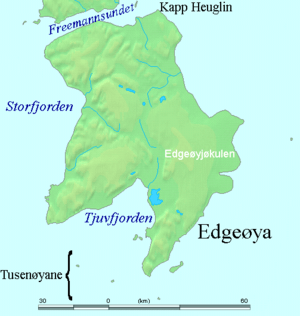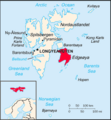Edgeøya facts for kids
Edgeøya is the third-largest island in Svalbard, a group of islands far north in Norway. It is located east of Spitsbergen, which is the biggest island in Svalbard. Today, no one lives permanently on Edgeøya. But if you visit, you can find old signs that people once lived there. These include simple huts left by Russian hunters called Pomors, who might have arrived as early as the 1500s. You can also see abandoned stations where people used to hunt whales.
Contents
Exploring Edgeøya
Edgeøya is a wild and beautiful place, mostly covered by glaciers and a type of cold grassland called tundra. It is part of the Southeast Svalbard Nature Reserve, which means its nature and wildlife are protected. This helps keep the island safe for the animals that live there.
Who Lived on Edgeøya?
Even though no one lives on Edgeøya now, people have visited and stayed there for hundreds of years.
The Pomors
The Pomors were Russian hunters and traders who explored the Arctic. They came to Edgeøya as early as the 16th century, around the 1500s. They built simple wooden huts to live in while they hunted animals like walruses, seals, and polar bears. They used these animals for their fur, meat, and blubber (fat). These huts are some of the oldest signs of human activity on the island.
Whaling Stations
Later, in the 17th and 18th centuries, European whalers came to the waters around Edgeøya. They hunted large whales for their oil, which was used for lamps and other products. They set up whaling stations on the coast. These stations were like small factories where they processed the whales. Over time, as fewer whales were found and other energy sources became popular, these stations were abandoned. You can still see the remains of these old stations today.
Nature and Wildlife
Edgeøya is an important home for many Arctic animals.
Arctic Animals
The island is famous for its large population of polar bears, which often roam the ice and land. You might also spot Svalbard reindeer, a special type of reindeer that lives only in Svalbard. Many different kinds of sea birds nest on the cliffs during the summer. In the waters around the island, you can find walruses resting on the ice or beaches.
The Landscape
Much of Edgeøya is covered by large ice caps and glaciers, especially in the eastern parts. The western parts have more areas of tundra, where small plants, mosses, and lichens grow. This tough vegetation can survive the cold Arctic climate. The island's rugged coastline has many fjords and bays.
Images for kids
See also
 In Spanish: Edgeøya para niños
In Spanish: Edgeøya para niños




